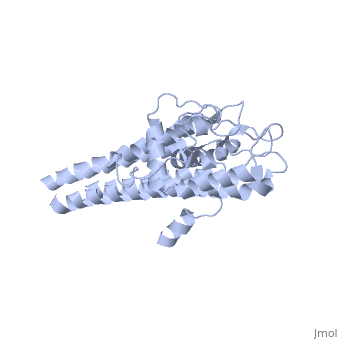VlsE of Borrelia
From Proteopedia
Lyme disease is a multistage, tick-borne infection that is prevalent in the United States, Europe, and Asia. The contributing bacterium that is related to this disease is the spirochete, Borrelia burgdorferi. VlsE is the lipoprotein of the Borrelia burgdorferi bacteria, which undergoes antigenic variation and plays a major role in the immune response to Lyme disease. A lipoprotein is a structure that contains both proteins and lipids, which allows the protein to integrate with the plasma membrane as a surface protein. It has an effective strategy developed by pathogenic microorganisms to evade the host immune system. The immune system normally reacts to antigens by producing particular antibodies to target that specific antigen. Memory B-cells will retain the proper antigenic counter for the foreign body. However, a variable antigen will frequently change the binding site, so the body will have to constantly look for a new antibody to target. Lyme disease can cause chronic neurologic, cardiovascular, and arthralgic manifestations lasting from months to years. Its persistence is due to the variable properties of the antigen, therefore it is important to understand the structure of VlsE to better counter this disease.
Contents |
Structure of VlsE
|
VlsE contains N and C terminus, which correspond to the start of the amino acid sequence to the end, respectively. Unlike other proteins, the N and C terminus regions are neighbored and very flexible. Due to the fact that these regions do not change sequence, they are heavily used for diagnostic tests and vaccination experiments. The N-terminal doesn't relay any information on its antigenicity, however, the C-terminal region is found to be highly immunogenic. Experiments involving treatment with antisera have shown the alpha structure of the C-terminal region associated with the immunogenicity to vary among Lyme disease borrelia (Chandra et.al, 2011). The peptide associated with this immunogenicity is membrane proximal and surface exposed, although crowding of VlsE proteins or bonding to other proteins may block exposure (Liang & Philipp, 1999).
Burgdorferi uses antigenic variation to evade the host immune system. It uses genetic recombination as its antigenic variation strategy. The genes coding for VlsE’s variable regions are replaced by replicated vls silent cassette sequences on the B-31 locus, just upstream form the VlsE expression site, that are up to 92% similar to the corresponding VlsE sequences. This gene recombination results in many slightly varied versions of the VlsE antigen.
Relation to Lyme Disease
Future Directions
Further research must be done to determine why some immunodominant regions are not accessible to the antibody on the surface of spirochetes. For instance, IR6 is not accessible to the antibody on the spirochete but is only available non-dimerized (Liang & Philipp, 1999). Understanding this would allow us to further determine how borrelia evade a host immune system, and would be another step in finding a cure to Lyme disease.
References
|
Proteopedia Page Contributors and Editors (what is this?)
William Ji, Priya Madan, Maayan Vizana, Garshaw Amidi-Abraham, Alexander Berchansky, Michal Harel

